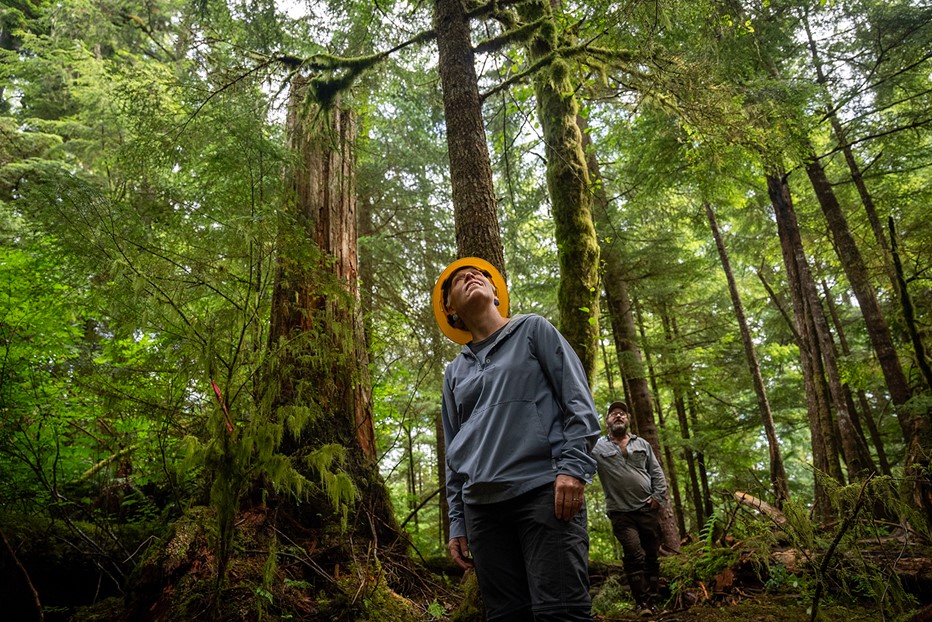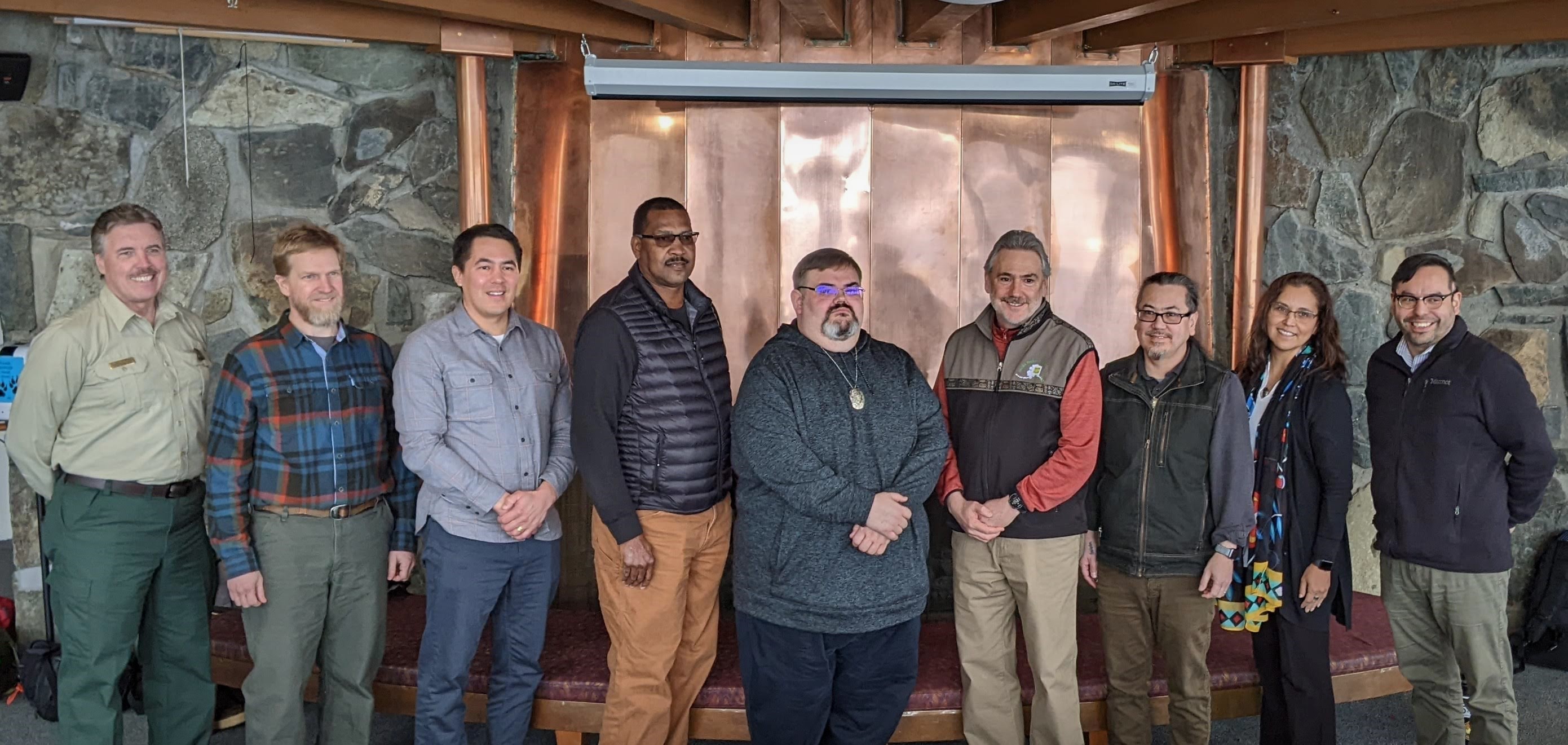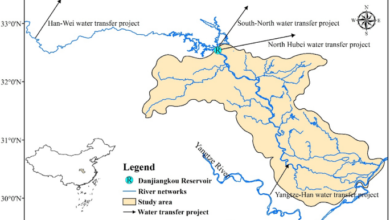Region 10 – Resource Management
Video: A few stories of the community, economical, and environmental impacts from the Southeast Alaska Sustainability Strategy (SASS) in 2023.
What is the OneUSDA Southeast Alaska Sustainability Strategy (SASS)?
On July 15, 2021, the U.S. Department of Agriculture (USDA) announced the new Southeast Alaska Sustainability Strategy to support a diverse economy, enhance community resilience, and conserve natural resources in Southeast Alaska. The strategy to be undertaken on the Tongass National Forest and in Southeast Alaska includes four primary components:
- Ending large-scale old-growth timber sales on the Tongass National Forest and focusing management resources to support forest restoration, recreation, and resilience, including for climate, wildlife habit and watershed improvement.
- Restoring the 2001 Roadless Rule protections.
- Engaging meaningfully with Tribal Nations.
- Identifying short- and long-term opportunities for investments that reflect the diverse opportunities and needs in the region.
As a part of the strategy, the Secretary of Agriculture made an initial commitment of $25 million to the region and the Tongass is refocusing resources to implement an integrated forest management program.
Investments
A OneUSDA team comprised of the Forest Service, Rural Development, and Natural Resources Conservation Service engaged Southeast Alaska partners, communities, Tribal Nations and Alaska Native corporations in a process that reflects the immediate and long-term needs and opportunities in the region. This open-ended engagement ensured that investments were paired with a forward-looking approach to plan for longer-term action that is home-grown and responsive to local priorities, complements ongoing partnerships, and is inclusive of the values and peoples in the region.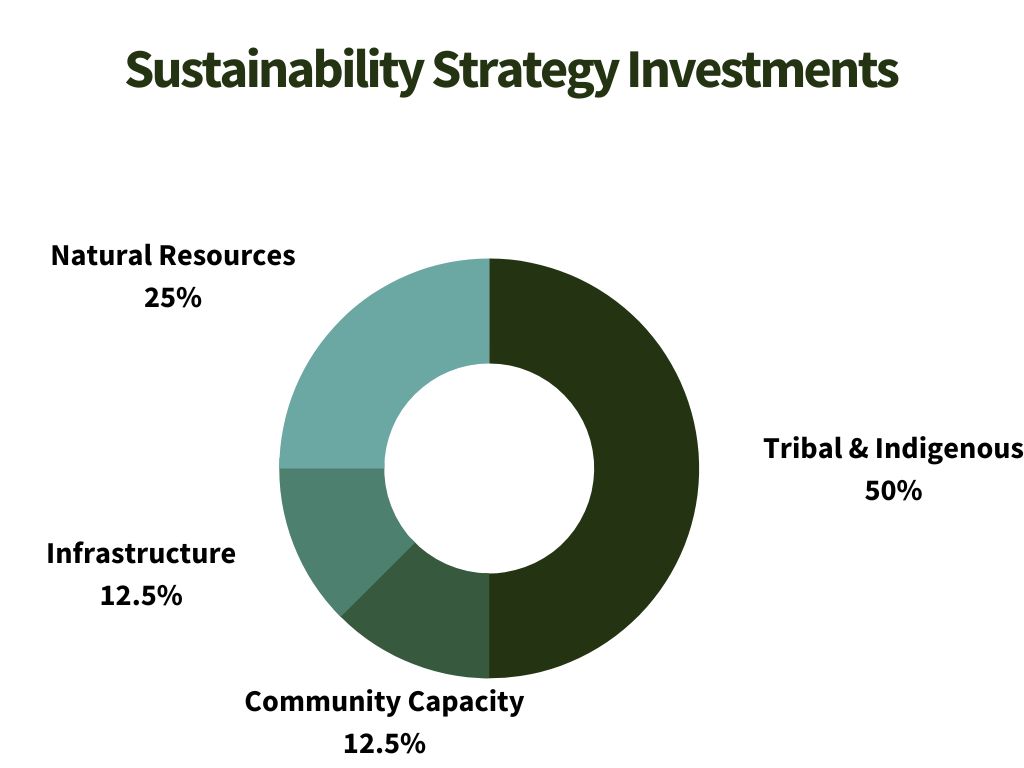
Since the Secretary’s announcement, over 270 investment proposals were received totaling more than $276 million. These proposals reflect the broad and deep need for economic stimulus in Southeast Alaska. these were narrowed down to 70 separate projects distributing the initial $25 million investment into four broad categories:
- Tribal and Indigenous Interests – $12.5 million (50%)
- Natural Resources – $6.25 million (25%)
- Infrastructure – $3.125 million (12.5%)
- Community Capacity – $3.125 million (12.5%)
SASS Investments are already making a difference.
Forest Management
In alignment with SASS, the Forest Service is refocusing resources on the Tong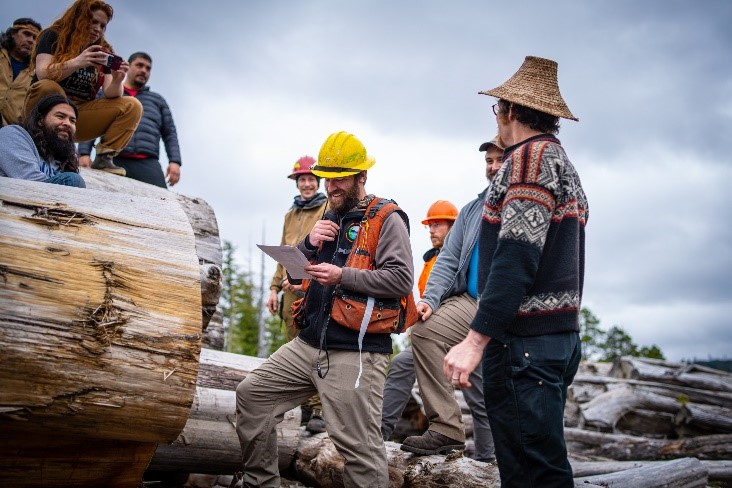 ass National Forest to implement an integrated forest management program that includes watershed and wildlife habitat restoration, sustainable young-growth harvest, and old-growth harvest for small timber sales and cultural uses. In April 2023, the Forest Service began a public engagement effort to gather input from the public. This effort, dubbed SASS-FM, resulted in more than 300 comments which were submitted through community workshops, engagement and consultation with tribal citizens and governments, meetings with partners, engagements with community groups and an interactive storymap.
ass National Forest to implement an integrated forest management program that includes watershed and wildlife habitat restoration, sustainable young-growth harvest, and old-growth harvest for small timber sales and cultural uses. In April 2023, the Forest Service began a public engagement effort to gather input from the public. This effort, dubbed SASS-FM, resulted in more than 300 comments which were submitted through community workshops, engagement and consultation with tribal citizens and governments, meetings with partners, engagements with community groups and an interactive storymap.
This input received will help finalize the assessment criteria and develop a list of priority projects for the next ten years. These projects cannot be completed without partnerships, so the Forest Service will host another workshop this winter to finalize the list and collaborate with partners to complete the work.
SASS-FM participants were also asked to share what they believe to be the most important benefits integrated forest management can produce for their communities. The diverse perspectives shared have given us a series of common themes to help guide the next steps in the process. What we heard:
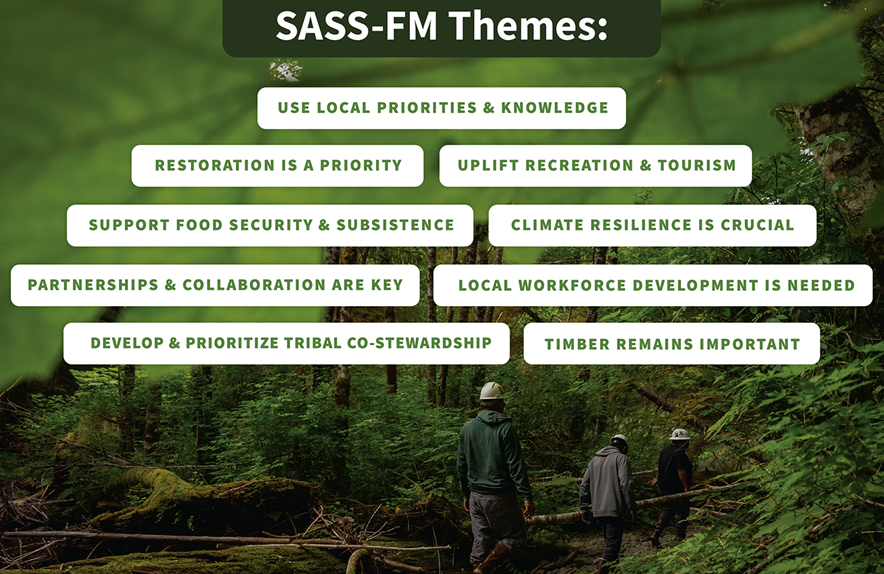
SASS News
Key Milestones:
Tongass National Forest – News & Events (usda.gov)
Frequently Asked Questions
The Southeast Alaska Sustainability Strategy is USDA’s approach to support economic, cultural, and natural resources sustainability in the region. Southeast Alaska’s culture, people, and economy are interwoven with the Tongass National Forest. The strategy prioritizes USDA resources and capacity to better serve the broader economy of Southeast Alaska. We look to be part of an inclusive, responsive approach that complements existing efforts toward practical, common-sense solutions. Our initial Economic Investment effort will commit up to $25 million in federal funding based on local priorities for short-term, project-based investments.
The Alaska-based, USDA intra-agency team is co-led by Rural Development, Natural Resources Conservation Service, and the Forest Service. This team is locally based and will continue to consult with Tribal Nations and Alaska Native corporations and to engage with partners and municipal governments to continue to identify priorities and practical opportunities for investments of financial and technical assistance.
USDA is focused on maximizing its collective resources to provide the highest level of support and service to Southeast Alaska. Overall outcomes anticipated include stronger relationships with Tribal Nations, Alaska Native corporations, and municipal governments; inclusive, diverse engagements that represent the people, communities, and cultures of Southeast Alaska; an understanding of administrative barriers that continue to impact funding distribution and may include changes to policies, laws, and regulations; and be able to use input gained from engagements to determine short- and long-term investments for the region.
In addition to the Economic Investment component, the Southeast Alaska Sustainability Strategy also involves ending large-scale, old-growth timber harvest and focusing resources to support forest restoration, recreation, climate resilience, and sustainable young-growth management. It also includes a proposal to restore the 2001 Roadless Rule protections on the Tongass and to engage in meaningful consultations with Tribal Nations and Alaska Native corporations.
The commitment identifies short investments that reflect diverse investment opportunities and needs in the Southeast Region. The initial $25 million investment will be divided into four broad categories:
- Tribal and Indigenous Interests – $12.5 million (50%)
- Art and Culture
- Food Security and Sovereignty
- Shared Stewardship
- Traditional Technical Knowledge and Cultural Use of Forest Products
- Workforce Development Projects
- Natural Resources – $6.25 million (25%)
- Agriculture
- Mariculture
- Restoration
- Young Growth Forest Management
- Infrastructure – $3.125 million (12.5%)
- Recreation Sites
- Renewable energy
- Waste management projects
- Community Capacity – $3.125 million (12.5%)
- Tourism and Business Development
- Tribal and Community Youth Engagement
- Community Workforce Development
USDA’s initial commitment of $25 million to support investment efforts is a positive, near-term commitment in the region’s long-term potential to support a diverse economy, conserve natural resources, and improve community resiliency.
The OneUSDA team employed a four-step assessment process to inform its recommendation for the initial investment of $25 million. The Team first used coarse filters to assess investment readiness, and then used an expanded review team to conduct a qualitative assessment. Each idea or proposal was read by multiple reviewers. This qualitative assessment included review of the following elements:
- Inclusion of a strong set of partners.
- Representation of a priority economic sector.
- Addresses critical community capacity needs and/or increases capacity.
- Meets USDA commitment to ecological, economic, and cultural sustainability.
- Addresses historic and/or structural decisions that previously contributed to inequitable access to USDA programs.
The depth of interest, and diversity of communities and partners that submitted investment ideas, indicates that USDA is well-positioned to support economic, cultural, and ecological resiliency in Southeast Alaska for the long-term. Federal funding from recent and proposed legislation, like the Great America Outdoors Act, the Bipartisan Infrastructure Deal, and other agency appropriations, can likely fund many of the investment ideas that were not quite ready for short-term support.
The USDA intra-agency team continues to engage with Tribal Nations, Alaska Native corporations, municipal governments, local partners and communities, and the public to support economic development planning and implementation efforts. USDA plans to leverage its resources to support these efforts including programs to strengthen small businesses, broadband, renewable energy production, local foods and agriculture production, water and sewer infrastructure, healthcare, housing, outdoor tourism, silviculture support and others as appropriate. Our long-term strategy will include establishing an interagency lead for the Sustainability Strategy, establishing a team charter for the Alaska-based OneUSDA team, and empowering shared leadership within the region by aligning programs with locally developed strategies such as the Blueprint for Southeast Alaska, the Visitor Products Cluster Working Group, the 2025 Economic Development Plan, and the All Landowners Working Group, among others.
A USDA intra-agency team consulted with Tribal Nations and Alaska Native corporations, and engaged with municipal governments, local partners and communities, and the public to support an integrated approach to economic development planning and implementation. USDA will leverage its resources to support these efforts including programs to strengthen small businesses, broadband, renewable energy production, local foods and agriculture production, water and sewer infrastructure, healthcare, housing, outdoor tourism, silviculture support and others as appropriate.
The intra-agency team collected diverse public input to inform opportunities for priority investments and in reducing administrative barriers that support a diverse economy, enhance community resilience, and conserve natural resources. The team used a two-pronged approach to gather public input. It conducted targeted engagement with key partners and provided opportunities for citizens and organizations to participate in shaping the economic investment component of the strategy.
The intra-agency team reached out to schedule tribal consultations and sessions to engage and inform participants about the strategy and engage in discussions about opportunities for economic investments. Discussions also focused on identifying administrative barriers to federal funding. Meanwhile, broad public engagement, in the form of a 30-day public outreach period, was held in mid-September through mid-October with several of platforms offered for additional engagement. This included virtual Open Houses, an online feedback tool, an information-filled website, and a dedicated email address for submitting input, letters, and/or existing plans or specific investment proposals.
March 2022 SASS meeting in Juneau, Alaska. USDA Forest Service photo. Pictured left to right: Earl Stewart – Forest Supervisor Tongass National Forest, Chad VanOrmer – Deputy Regional Forester, Anthony Mallott – Sealaska CEO, Dr. Homer Wilkes – Under Secretary for Natural Resources and Environment, Richard Chalyee Éesh Peterson – Central Council of the Tlingit & Haida Indian Tribes of Alaska President, Dave Schmid – Regional Forester, Joe Kaaxúxgu Nelson – Sealaska Board Chair, Jaeleen Kookesh – Sealaska Vice President, Policy & Legal Affairs, and Raymond Paddock – Environmental Manager for Central Council of the Tlingit & Haida Indian Tribes of Alaska.
